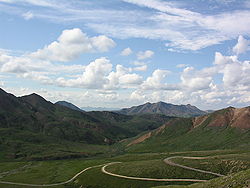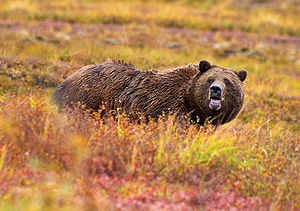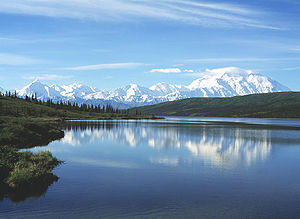Denali National Park and Preserve
| Denali National Park and Preserve | |
|---|---|
| IUCN Category II (National Park) | |
| | |
| Location: | Alaska, USA |
| Nearest city: | Healy, AK |
| Area: | 6,075,107 acres (24,585 km²) |
| Established: | February 26, 1917 |
| Visitation: | 1,178,745 (in 2005) |
| Governing body: | National Park Service |
Denali National Park and Preserve is located in Interior Alaska and contains Mount McKinley(Denali), the tallest mountain in North America. The park and preserve together cover 9,492 mi² (24,585 km²).
Overview
The word "Denali" means "the great one" in the native Athabaskan language and refers to the mountain itself. The mountain was named after president William McKinley of Ohio in 1897 by local prospector William A. Dickey, although McKinley had no connection with the region.
Charles Sheldon took an interest in the Dall sheep native to the region, and became concerned that human encroachment may threaten the species. After his 1907-1908 visit, he petitioned the people of Alaska and Congress to create a preserve for the sheep. (His account of the visit was published posthumously as The Wilderness of Denali, ISBN 1-56833-152-5). The park was established as Mount McKinley National Park on February 26, 1917. Ironically, only a portion of Mount McKinley (not even including the summit) was within the original park boundary. The park was designated an international biosphere reserve in 1976. A separate Denali National Monument was proclaimed by Jimmy Carter on December 1, 1978.
Mount McKinley National Park, whose name had been subject to local criticism from the onset, and Denali National Monument were incorporated and established into Denali National Park and Preserve by the Alaska National Interest Lands Conservation Act, December 2, 1980. At this time the Alaska Board of Geographic Names changed the name of the mountain back to "Denali," even though the U.S. Board of Geographic Names maintains "McKinley". Alaskans tend to use "Denali" and rely on context to distinguish between the park and the mountain. The size of the national park is over 6 million acres (25,000 km²), of which 4,724,735.16 acres (19,120 km²) are federally owned. The national preserve is 1,334,200 acres (543 km²), of which 1,304,132 acres (5,278 km²) are federally owned. On December 2, 1980, a 2,146,580 acre (8,687 km²) Denali Wilderness was established within the park.
Denali habitat is a mix of forest at the lowest elevations, including deciduous taiga. The preserve is also home to tundra at middle elevations, and glaciers, rock, and snow at the highest elevations. Today, the park hosts more than 400,000 visitors who enjoy wildlife viewing, mountaineering, and backpacking. Wintertime recreation includes dog-sledding, cross-country skiing, and snowmobiling where allowed.
The national park is located near Denali State Park.
Wildlife
Denali is home to a variety of Alaskan birds and mammals, including a healthy population of grizzly bears and black bears. Herds of caribou roam throughout the park. Dall sheep are often seen on mountainsides, and moose feed on the aquatic plants of the small lakes and swamps. Despite human impact on the area, Denali accommodates gray wolf dens, both historic and active. Smaller animals, such as hoary marmots, arctic ground squirrels, beavers, pikas, and snowshoe hares are seen in abundance. Foxes, martens, lynx, wolverines also inhabit the park, but are more rarely seen due to their elusive natures.
The park is also well known for its bird population. Many migratory species reside in the park during late spring and summer. Birdwatchers may find waxwings, arctic warblers, pine grosbeaks, and wheatears, as well as Ptarmigan and the majestic tundra swan. Predatory birds include a variety of hawks, owls, and the gyrfalcon, as well as the abundant but striking golden eagle.
Ten species of fish, including trout, salmon, and arctic grayling share the waters of the park. Because many of the rivers and lakes of Denali are fed by glaciers, glacial silt and cold temperatures slow the metabolism of the fish, preventing them from reaching normal sizes. A single amphibious species, the wood frog, also lives among the lakes of the park.
Denali park rangers maintain a constant effort to "keep the wildlife wild" by limiting the interaction between humans and park animals. Feeding animals is strictly forbidden, as it may cause adverse affects on the feeding habits of the creature. Visitors are encouraged to view animals from safe distances. Despite the large concentration of bears in the park, efforts by rangers to educate backpackers and visitors about preventative measures and BRFCs have greatly reduced the number of dangerous encounters. Certain areas of the park are often closed due to uncommon wildlife activity, such as denning areas of wolves and bears or recent kill sites. These restricted areas may change throughout the year. Through the collective care of park staff and visitors, Denali has become a premier destination for wildlife viewing.
Flora
The Alaska Range, a mountainous expanse running through the entire park, provides interesting ecosystems in Denali. Because the fall line lies as low as 2,500 feet, wooded areas are rare inside the park, except in the flatter western sections surrounding Wonder Lake, and lowlands of the park where flowing waters melt the frozen ground. Spruces and willows make up the majority of these treed areas. Because of mineral content, ground temperature, and a general lack of soil, areas surrounding the bases of mountains are not suitable for sufficient tree growth, and most trees and shrubs do not reach full size.
Tundra is the predominate ground cover of the park. Layers of topsoil collect on rotten, fragmented rock moved by thousands of years of glacial activity. Mosses, ferns, grasses, and fungi quickly fill the topsoil, and in areas of "wet tundra," tussocks form and may collect algae. Wild blueberries and soap berries thrive in this landscape, and provide the bears of Denali with the main part of their diets.
Over 450 species of flowering plants fill the park, and can be viewed in bloom throughout summer. Images of goldenrod, fireweed, lupine, bluebell, and gentian filling the valleys of Denali are often used on postcards and in artwork.
Vehicle access
The park is serviced by a 91-mile road from the Parks Highway to the mining camp of Kantishna. Only a small fraction of the road is paved because permafrost and the freeze-thaw cycle create an enormous cost for maintaining the road. Private vehicles are only allowed on the road in early spring and late fall. During the summer, visitors must access the interior of the park through buses operated by concession.
Several fully-narrated tours of the park are available, the most popular of which is the Tundra Wilderness Tour. The tours travel from the initial boreal forests through tundra to the Toklat River or Kantishna. A clear view of the mountain is only possible about 20% of the time during the summer, although it is visible more often during the winter. Several portions of the road run alongside sheer cliffs that drop hundreds of feet at the edges, and the extreme conditions prevent construction of guardrails. As a result of the danger involved, and because most of the gravel road is only one lane wide, drivers are trained extensively in procedures for navigating the sharp mountain curves, and yielding the right-of-way to opposing buses and park vehicles.
Denali itself is not accessible by motor vehicle; the road ends 37 miles (59 km) to its east.
Fossils
Denali is emerging as a site of interesting fossils, including footprints (ichnites) that were credited with being the first evidence of prehistoric wading birds, probing in mudflats for food during the Late Cretaceous Period, when they were first publicly reported in May 2006. A footprint of a carnivorous theropod had previously been reported in the park.
Sources and Further Reading
- Bauer, Erwin A., and Peggy Bauer. 2000. Denali: the wild beauty of Denali National Park. Seattle: Sasquatch Books. ISBN 1570612099 and ISBN 9781570612091
- Catton, Theodore. 1997. Inhabited wilderness Indians, Eskimos, and national parks in Alaska. New American West series. Albuquerque, N.M.: University of New Mexico Press. ISBN 0585187614 and ISBN 9780585187617
- Petersen, David. 1996. Denali National Park and Preserve. A true book. New York: Children's Press. ISBN 051620050X and ISBN 9780516200507
- Hall, Margaret. 2007. Welcome to Denali National Park. Visitor guides. Chanhassen, Minn: Child's World. ISBN 1592966950 and ISBN 9781592966950
- Miller, Debbie S., and Jon Van Zyle. 1997. Disappearing lake: nature's magic in Denali National Park. New York: Walker and Co. ISBN 0802784747 and ISBN 9780802784742
External links
- Denali. National Park Service. Retrieved May 19, 2007.
- Major Attractions: Denali National Park and Preserve. The Milepost. Retrieved May 19, 2007.
- Denali National Park’s Top Rated Backcountry Lodge. Kantishna Roadhouse. Retrieved May 19, 2007.
Credits
New World Encyclopedia writers and editors rewrote and completed the Wikipedia article in accordance with New World Encyclopedia standards. This article abides by terms of the Creative Commons CC-by-sa 3.0 License (CC-by-sa), which may be used and disseminated with proper attribution. Credit is due under the terms of this license that can reference both the New World Encyclopedia contributors and the selfless volunteer contributors of the Wikimedia Foundation. To cite this article click here for a list of acceptable citing formats.The history of earlier contributions by wikipedians is accessible to researchers here:
The history of this article since it was imported to New World Encyclopedia:
Note: Some restrictions may apply to use of individual images which are separately licensed.




